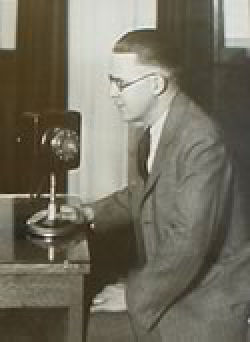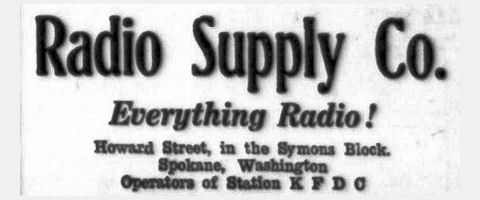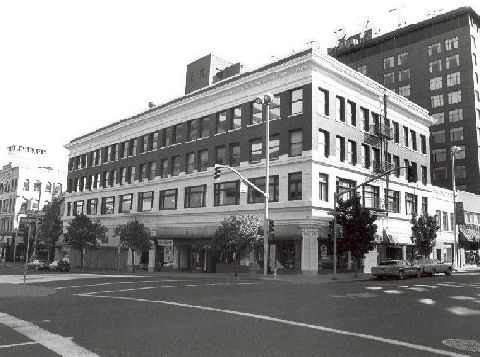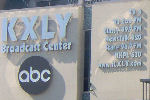THE EARLY YEARS - 1922 to 1928
KFDC
KFDC, KXLY's first predecessor, went on the air on 18 October 1922 according to Spokane radio pioneer Edmund "Ed" Blodgett Craney (1905 - 1991). The Department of Commerce (DOC) files show that the station was licensed on 22 November 1922 by the Radio Supply Co., E. B. Craney applicant. The October starting date makes sense because, in the early 1920's, stations had to be on the air for at least thirty days before the Department of Commerce would issue a license.
In an interview in the 1970's by the Washington State Association of Broadcasters (WASB), Craney noted that in 1922, "there was no real broadcast station in Spokane" and "we had had sort of a station working. It was an unlicensed radio school station run by Pacific Telegraph, which sold radio parts." Additionally, there was an amateur radio operator named Mr. Olsen, who worked for the Washington Water Power and put a broadcast station on the air for two hours per day playing records. Finally, the Spokane Chronicle licensed a station (KOE) which was on the air for only a short time, and Doerr-Mitchell Electric Company operated radio station KFZ for roughly a year.
 Right - Ed Craney at the microphone, undated
Right - Ed Craney at the microphone, undated(Courtesy of Montana Broadcasting Association)
After convincing Thomas "Tom" Symons, Jr., Craney's employer at the Radio Supply Co., that they should set up a radio station to sell their radio parts, Craney went to Seattle to attend a radio school at the local YMCA and to take a commercial license examination. He passed the examination and received his commercial license, and with the encouragement and assistance of Mr. Symons, Craney applied for a station license at the age of 17 and received one for KFDC.
 (The only known newspaper ad
that mentions KDFC - From the Spokane Daily Chronicle - 12
January 1923.)
(The only known newspaper ad
that mentions KDFC - From the Spokane Daily Chronicle - 12
January 1923.)
The station started out with 5 watts and covered a small area in downtown Spokane. The transmitter was in the Symons Block and the antenna spanned First Avenue and was attached on the other end on a theater sign on the Columbia Block. The station "got down to Sprague," according to Craney, who thought "that was pretty good" at the time. Sometime later the station's power increased from 10 watts. A studio was built subsequently built on the roof of the Symons Building and an antenna structure was built on the roof as well. The station initially broadcast on 833 kHz and switched to 1060 kHz on 29 May 1923, according to DOC records, sharing this frequency with KFZ, a station owned by Doerr-Mitchell Electric Company, the predecessor to Columbia Lighting.
Frequency stability was an issue in the early days. Craney noted that when the station operated on 360 meters (833 kHz), the "wavelength didn't mean very much; because what you did was take a receiver and adjust the transmitter to some place on the receiver where you could pick it up." According to Craney, frequency control a little better when they used a REL Wave Meter and even better when they used crystal controlled units.
KFDC's first license dated 23 November 1922.
KFPY
KXLY's second predecessor was KFPY. The license for KFDC was allowed to lapse and was deleted on 19 September 1923. Tom Symons, Ed Craney's boss, re-applied to the DOC for a license and received one for KFPY on 23 April 1924, this time the licensee was Symons Investment Company. Craney was still involved in the technical side of making the station operate. KFPY resumed using 1060 KHz, starting with 50 watts from the same location as KFDC. The Department of Commerce's Radio Service Bulletin list of stations, as of 28 February 1925, listed KFPY as using 100 watts on 1130 KHz. By 1927, KFPY was sharing 1220 kHz with KFIO and was operating with 250 watts.
The station experienced audio problems. Craney recalled that when the station went to 50 watts in 1924, "our biggest problem was that the radio signals had a tremendous hum in them. We were using a motor generator for the DC supply on the plates of the tubes." This created a hum which they did not know at the time how to filter out. Craney ended up purchasing two-banks of B batteries, with 3,000 volts in each bank. Having two banks of batteries was convenient because "downtown Spokane was on DC current in those days, and it wasn't anything at all to charge batteries with DC current. All you had to do was connect them up to the line and let them charge. You had 220 volts DC that you could use for charging the batteries. That cleaned up the signal real nice. We had no trouble after we switched to batteries."
Long distance listeners and other stations played an important role in the station's development. According to Craney, stations would use the time after midnight to talk to other broadcast and amateur stations to test their transmitters and improve their signals. The first modulation was done with a device called an absorption loop. Craney noted that this produced a very low level of modulation, and that the best way to get distant receptions was to use Morse code by keying the transmitter off and on. Long distance radio listening hobbyists (DXers) showed interest in the station, sending for verifications of reception. A DXer in England became the first known overseas listener to hear a Spokane radio station in 1925 when he heard a storm related announcement.
In its infancy, radio was a curiosity according to Craney. Most of the listeners were the DXing type. It wasn't until "name entertainment" and programs like Jack Benny, Eddie Cantor, and Amos and Andy came along that radio became a more popular medium. President Franklin Roosevelt further popularized radio with his fireside chats.
By 1925, KFPY had many dedicated listeners. The station opened its doors at the Symons Block studio to the general public for the first time on 11 November 1925 between 7:30 and 9:00 PM. According to Craney, "Because we have been asked by so many people to allow them to see our station, we have set aside Wednesday evening as visitors' evening at KFPY." A special Armistice Day program was planned for the evening. Craney noted that KFPY received about 75 calls during the usual Wednesday program but expected more calls this time because of the special program.
In 1927, Craney went to Butte, Montana to sell radios for
Symons. He went on to establish radio stations in Butte (KGIR
later KXLF), Helena (KXLJ), Bozeman (KXLQ), Great Falls (KXLK),
and Missoula (KXLL) as part of the Z-Bar Network. He managed KGIR
for a time beginning in late 1928. Later, he was the driving
force behind putting several television stations on the air in
Montana as well as KXLY-TV in Spokane. He was also a pioneer and
a driving force behind the use of television translator stations.

Above - Symons Block - The Home of KFDC/KFPY/KXLY
1922-1950
(Courtesy of Spokane City-County Historical Preservation
Office)
The current Symons Block building, which housed Radio Supply, Co. and KFDC/KFPY, was built in 1917. Colonel Thomas Symons, Thomas Symons Jr.'s father, built two structures on this site before 1917. Among the celebrities who entered the studios were hometown favorites Bing Crosby, Bob Crosby, and Patrice Munsel, who all debuted on local Spokane radio broadcasts before they became famous.
KFPY's first license dated 23 April 1924.
Compiled and edited by Bill Harms - updated 26 March 2009
SOURCES
- "Broadcasting Stations Alphabetically by State and City." Radio Service Bulletin. Complete to 30 January 1926, #106, Pages 8-20. Department of Commerce, Washington, DC.
- "Broadcasting Stations Alphabetically by State and City Effective 15 June 1927." Radio Service Bulletin. Published May 31, 1927 Pages 5-10#122. Department of Commerce, Washington, DC.
- "Broadcasting Stations of the United States by Wavelengths as of 28 February 1925." Radio Service Bulletin. 1 March 1925, #95, Pages 9-13. Department of Commerce, Washington, DC.
- Craney, Edmund Blodgett. Washington State Association of Broadcasters Oral History Project. Interview 19 December 1975 by Bill Moore.
- Craney, Edmund Blodgett. Washington State Association of Broadcasters Oral History Project. Interview mid-1977 by Hugh Rundell.
- KFDC License Records, Radio Service, Department of Commerce. Washington, DC. 23 November 1923. Reproduced at the National Archives, College Park, Maryland.
- KFPY License Records, Radio Service, Department of Commerce. Washington, DC. 23 April 1924. Reproduced at the National Archives, College Park, Maryland.
- Marquand, Ian. 100 Most Influential Montanans of the Century, No. 80 - Ed Craney. The Missoulian. Missoula, Montana. http://www.missoulian.com/specials/100montanans/list/080.html - Last accessed on 30 May 2005.
- "MBA HALL OF FAME - Edmund Blodgett Craney (1905 - 1991.)" Montana Broadcasters Association. http://www.mtbroadcasters.org/hall_of_fame/edmund_craney.html - Last accessed 30 May 2005.
- Open House Planned by KFPY Previous to Going On Air. Spokesman-Review, Spokane, Washington. 11 November 1925. Page 10.
- Scott, Xen. Transcription of FCC microfiche files KXLY and KFPY, November 11, 1994.
- Social Security Administration. Social Security Death Index, Master File. Provo, Utah: MyFamily.com, Inc.
- Spokane Register of Historic Places Nomination Form for Symons Building. Application made in 1995 to the City/County Historic Landmarks Commission, Sixth Floor, City Hall, Spokane, Washington.
- "Stations Broadcasting Market or Weather Reports (485 meters) and Music, Concerts, Lectures, etc. (360 meters) (March 10, 1922.)" Radio Service Bulletin. 1 March 1922, #59, Pages 23-25. Department of Commerce, Washington, DC.
- "Stations Broadcasting Market or Weather Reports (485 meters) and Music, Concerts, Lectures, etc. (360 meters), Alphabetically by Call Letters." Radio Service Bulletin. 1 May 1922, #61, Pages 19-22. Department of Commerce, Washington, DC.
- "Stations Broadcasting Market or Weather Reports (485 meters) and Music, Concerts, Lectures, etc. (360 meters), Alphabetically by Call Letters." Radio Service Bulletin. 1 December 1922, #68, Page 2. Department of Commerce, Washington, DC.
- "Stations Broadcasting Market or Weather Reports and Music, Concerts, Lectures, etc. Alphabetically by Call Letters." Radio Service Bulletin. 1 June 1923, #74. Department of Commerce, Washington, DC.
- "Stations Broadcasting Market or Weather Reports and Music, Concerts, Lectures, etc. Alphabetically by Call Letters." Radio Service Bulletin. 30 June 1923 #75. Department of Commerce, Washington, DC.
- "Stations Broadcasting Market or Weather Reports and Music, Concerts, Lectures, etc. Alphabetically by Call Letters." Radio Service Bulletin. 1 October 1923, #78. Department of Commerce, Washington, DC.
- "Symons Gets Butte Station." Spokesman-Review. Spokane, Washington. 30 November 1928.










